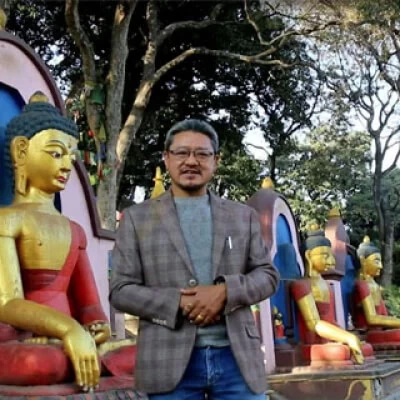In Nepal, each day is dedicated to a deity and considered auspicious or unfavorable for certain occupations. Only Tuesdays and Thursdays are truly favorable for all types of work. Since Saturday is a holiday, the week is considerably shorter. The equinoxes, solstices, full moons, gods' birthdays, the beginning of the harvest, and the end of the harvest are all pretexts for festivals—which are not, however, days off. Transcribed according to the Christian calendar, here are the main Nepalese festivals, almost all of which are religiously inspired. Their dates are not fixed and can vary by a few days each year. Moreover, they are often local and, sometimes, purely family-related.
Fêtes principales du Népal
Table of Contents
The legendary origin of the monsoon
Originating in the Bay of Bengal, the monsoon forms a mass of humid air that, as it rises into the air, condenses to transform into rain. It plays a vital role in Nepal's economy, which relies primarily on agriculture
The Machendra Nath Yatra festival aims to obtain the rains needed for crops and has its origins in ancient mythical fertility cults. It took on exceptional importance under King Narendra Deva, whose reign (645-680) was marked by a drought that lasted 12 years. Legends blame a hermit who lived in a cave in Gorkha and wanted above all to see Machendranath; to achieve this, he enclosed the clouds in a bag and sat on it, hence the drought. When Machendrenath arrived in the region, the monk stood up to bow to him, the clouds escaped, and the immediate consequence was the onset of the monsoon. King Narendra Deva, out of gratitude, placed the Kathmandu Valley under the protection of this god, seeing in him the savior of Buddhism.
Women's Day (Tij Festival
On the eve of their special festival (tij), women can demand that their husbands fulfill all their desires. Many women take advantage of this opportunity to drag their husbands to the shops of Kathmandu. The next day, adorned in their new finery, they fast, dance, and sing in Shiva temples, especially in Pashupatinath. They offer gifts to the god and worship his great linga before bathing in the waters of the Bagmati River to purify themselves and achieve a long and happy married life. If they fail to fulfill this rite, they risk losing their husbands within the year.
This celebration draws its inspiration from Hindu mythology and the story of Parvati, daughter of the king of the Himalayas, whom Shiva wished to marry while her father had intended Vishnu for her. Having fled into the forest, she devoted her days to fasting and worshipping Shiva, who succeeded in convincing her father. She was finally able to marry him.
Only married women can celebrate this holiday; they take advantage of these two days to be free from domestic chores.
Nepalese Women's Day
September-October (Ashwin)
Dashain begins after the monsoon, on the first day of the 7th month of the Nepalese calendar, around mid-September. It is the most important traditional festival in Nepal. Its name comes from das, ten, because it lasts ten days. It is also called Navaratri, the "nine nights" or Durga puja, festival of the goddess Durga. It commemorates the victory of Good over Evil. Hindus prefer to honor the goddess Durga, assimilated to "mother earth." On the first day, or Jamara Aunci, Brahmins sow barley in a dark room. Ten days later, they distribute the sprouts to the faithful who will carry them as an offering to the goddess. This first day is also marked by the construction of bamboo resting places and ritual swings. On the 5th day, a kite flight takes place. On the 7th day, or Phulpati, the goddess is honored with the offering of flowers and leaves. The 8th day is dedicated to dogs and birds, and corresponds to our Good Friday. It is a day of fasting that prepares for the sacrifices the day after. On the 9th day, Naumi, the courtyards of Hanuman dhoka's palace are transformed into a fairground: rams, goats, and buffaloes are gathered to be sacrificed. Two men hold the animal's head against a tree, which the executioners must sever with a sharp blow, for if the beast does not die immediately, a curse falls on their family. The assistants dip their fingers in the blood to mark their foreheads with a tika and, since the flesh of these animals can be eaten, they indulge in a gigantic feast and copious libations that evening. The 10th day, or Vijaya Dashami, which marks the end of the festival's ceremonies and culmination, is dedicated to the elderly and ancestors. Many Nepalese go to their relatives' houses to receive the tika. Shops and government offices are closed, and life in the country is paralyzed.
October-November (Kartik
Tihar, or Festival of Lights, is a celebration common to India and Nepal. This festival celebrates the victory of Vishnu, who had taken possession of a city whose inhabitants had imagined lighting thousands of small lamps to guide the god who would deliver them. This festival lasts 5 days, successively worshipping the crow Kag-Tihar, the dog Kukur-Tihar, the cow Gai-Tihar, the ox Goru-Tihar, and the brother and brother Bhai-Tihar. The last day, Bhai-Tika, is the most important. Every man must honor his sister, visit her, and give her a garland of flowers.



February-March (Phalgun)
Shivaratri. The festival of Shiva, the god of destruction, commemorates the moment he opened his eyes after a long meditation. All Hindus in Nepal celebrate this anniversary; the largest ceremonies take place at Pashupatinath, in the Shiva temple
Holi or Fagu. This festival ends the year on the full moon of the month of Phalgun (February-March). Of Hindu origin and dedicated to Krishna, Holi is the ultimate celebration of color. A chir, a large wooden pillar with three tiers of parasols, is erected in the Basantapur square, near the old Royal Palace of Kathmandu. This pole symbolizes the past year, and the multi-colored flags adorning the parasols indicate the days that have passed.





